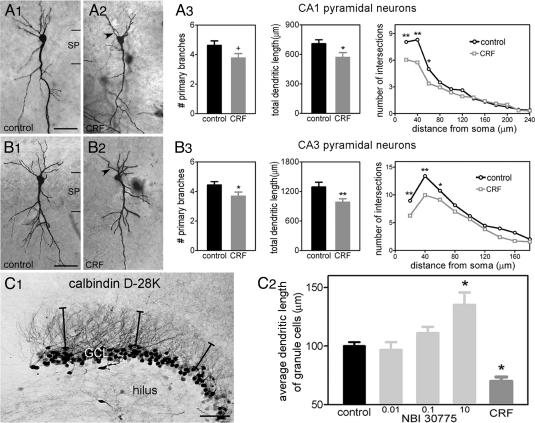Fig. 5.
Addition of synthetic CRF (A2 and B2) to hippocampal slice cultures reduces dendritic branching and length, evident from both Golgi impregnation and quantification of a dendritic marker. CRF exposure reduces number of primary dendrites (+, P = 0.056), total dendritic length (*, P < 0.05), and overall number of intersections (F[1, 360] = 13.50; P = 0.0003) (A3) in CA1. In CA3, number of primary dendrites (*,P < 0.05), dendritic length (**, P < 0.01), and number of intersections (F[1, 330] = 21.52; P < 0.0001) (B3) are reduced. Cultures were grown with CRF (1 μM, added on day 2) or CRF1 antagonist (0.01, 0.1, or 10 μM). n = 16 neurons per treatment per region. (C) Differential and opposing effects of CRF and CRF1 antagonist on dendritic growth also are evident when the dendritic marker calbindin D-28K is used (shown here for the granule cell dendrites in suprapyramidal blade of dentate gyrus). C1 illustrates calbindin-immunoreactive granule cells dendrites in a control culture. Lines from cell body to the tip of the dendrites were used to assess dendritic length. (C2) Exposure to CRF1 antagonist increases average dendritic length in a dose-dependent manner, whereas growing cultures in the presence of CRF reduces dendritic length (*, P < 0.05). SP, stratum pyramidale; GCL, granule cell layer. (Scale bars: A1 and A2, 45 μm; B1 and B2, 55 μm; C1, 25 μm.)

